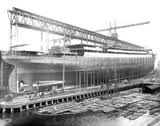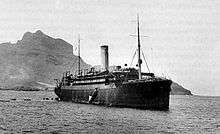SS Laurentic (1908)
SS Laurentic was a British ocean liner of the White Star Line. She was converted to an armed merchant cruiser at the onset of World War I, and sank after striking two mines north of Ireland on 25 January 1917, with the loss of 354 lives. She was carrying about 43 tons of gold ingots at the time of her loss, and as of 2017, 20 bars of gold are yet to be recovered.
_(cropped).jpg) SS Laurentic | |
| History | |
|---|---|
| Name: | Laurentic |
| Namesake: | St Lawrence River, Canada |
| Owner: | White Star Line |
| Port of registry: | Liverpool, United Kingdom |
| Route: | Liverpool to Quebec City |
| Ordered: | 1907 |
| Builder: | Harland and Wolff, Belfast |
| Yard number: | 394 |
| Launched: | 10 September 1908[1] |
| Completed: | 15 April 1909 |
| Maiden voyage: | 29 April 1909 |
| Fate: | Struck two mines and sank, 25 January 1917 |
| General characteristics | |
| Tonnage: | 14,892 GRT |
| Length: | 565 ft (172 m) |
| Beam: | 67 ft 3 in (20.50 m) |
| Decks: | 3 |
| Installed power: | Triple-expansion steam engines driving outboard propellers, with low-pressure turbine driving the centre propeller; 11,000 ihp (8,200 kW) |
| Propulsion: | Triple propeller installation |
| Speed: | 16 knots (30 km/h; 18 mph) |
| Capacity: |
|
Background

The Dominion Line steamship company operated a successful passenger service on their Liverpool-Canada route in the late 19th and early 20th centuries. Their ships had become outdated, so in 1907 two new liners were ordered from Harland and Wolff, and constructed at their yard in Belfast.[2] During their construction they were purchased by the White Star Line, and became its first ships in the Canadian passenger trade.[3]
The ships were originally named SS Alberta and SS Albany, and after the transfer of ownership Alberta was renamed Laurentic and her sister Albany became Megantic.[3]
Design
At the time, the two were the largest ships yet built for Canadian service and they were used as a form of full-scale experiment to decide on the machinery for the White Star Line's future Olympic-class ocean liners.[4] Megantic was built as a conventional twin-screw ship with conventional quadruple expansion engines, while Laurentic, with the same hull and boiler power, was given an experimental configuration known as 'combination machinery', consisting of three screws: The two wing propellers were driven by 4-cylinder triple expansion engines, while the third centre propeller was driven by a low pressure steam turbine, utilising the exhaust steam from the first two engines. Later comparisons of the performance of the two ships revealed that Laurentic produced 20% more power than her sister for the same steam consumption, and for the same power output, Laurentic's coal consumption was twelve to fifteen percent lower than that of Megantic. As the experiment was considered a success, the same arrangement was chosen for use in the three Olympic-class liners.[5][6]
Career
Laurentic was launched in 1908 and departed on her maiden voyage 29 April 1909, from Liverpool to Quebec City, with 1,057 passengers on board.[7] She normally served on the Liverpool-Canada route, and also stopped in New York during the winter months.[4] While crossing the Atlantic to New York on 22 January 1910, she was caught in a powerful storm; waves destroyed the windows of the upper deck and flooded the navigation bridge and the officers' quarters, disabling the service command transmitters. The ship survived, and arrived safely to port.[4] Laurentic gained notoriety later in 1910 during the capture of murderer Hawley Harvey Crippen, in which Chief Inspector Walter Dew of the Metropolitan Police used Laurentic's speed to arrive in Canada before the fleeing suspect on SS Montrose.[8]

During her regular service from Liverpool, Laurentic passed near where Titanic had sunk a few days earlier. On 21 April 1912 Captain John Mathias reported "he had kept a careful lookout while passing over the Grand Banks, and had seen neither bodies nor wreckage."[7]
In early August 1914, before Britain declared war on Germany in what was to become World War I, Laurentic sailed from Liverpool to Canada with her accommodations full of fleeing Europeans.[7] On 13 September, while at Montréal, she was commissioned as a troop transport for the Canadian Expeditionary Force, painted grey, and reclassified as HMS Laurentic.[2] Still captained by John Mathias, she joined a convoy of 32 ships that transported 35,000 Canadian soldiers to Europe in October 1914.[4][7] She was then converted to an auxiliary cruiser and fitted with seven cannon.[4]
In December 1914 she left Liverpool for Sierra Leone to assist in the Kamerun Campaign, and was involved mostly with the African theatre until the following summer.[9] In August 1915 she left for Singapore and spent the ensuing months on patrol around Singapore, Rangoon, and Hong Kong.[9] In June 1916 she left Asia en route to Halifax, Nova Scotia by way of Cape Town, and spent the following months patrolling near Halifax. Her patrol eventually moved southward to Bermuda, and then returned directly to Halifax in October.[9] In late November she departed for Liverpool, carrying Royal Canadian Navy officers, rated seamen, and Royal Canadian Naval Volunteer Reserves. During the voyage, Captain Mathias was accidentally struck by a steel beam while attempting to extinguish a coal fire, and died on 4 December of a fractured skull, two days before reaching Liverpool.[9]
Sinking
On 23 January 1917, Laurentic departed Liverpool en route to Halifax, under the command of Captain Reginald Norton.[10] She carried some 479 passengers, mostly naval officers, ratings, and Naval Volunteer Reserves, as well as a secret cargo of gold which was to be used for the purchase of war munitions from Canada and the United States.[10] On 25 January the ship made an unscheduled stop at the naval base in Buncrana, Ireland, to allow four passengers with yellow fever symptoms to disembark.[10] The ship lifted anchor around sunset, moving toward Fanad Head, where she was to meet with a destroyer escort. The weather was bitterly cold and a blizzard affected visibility, but Captain Norton gave the order to proceed without the escort, despite reports that a German U-boat had been spotted in the area earlier.[10] Less than an hour after leaving Buncrana, the ship struck two mines laid by the German mine-laying submarine U-80 off Lough Swilly.[2][10] One of the mines exploded near the engine room, which left the ship without power and caused it to list 20 degrees; the combination of the darkness and list made it difficult to lower the lifeboats, and made it impossible for the ship to issue a distress call.[10] Without power the main pumps were inoperable and the ship sank within an hour.
Those who made it onto lifeboats faced extreme cold as low as −13 °C (9 °F).[10] Survivors rowed towards Fanad Lighthouse, and some were rescued by local fishing trawlers.[10] In the morning, many were found frozen to death in their lifeboats, with their hands still gripping the oars.[10] The official count lists 475 passengers on board at the time of sinking, meaning that only 121 survived, and 354 were lost in the disaster.[8][9]
On 1 February, The New York Times reported that the last person to leave the ship was Captain Norton, who survived. He was quoted as saying: "To the best of my knowledge, all the men got safely into the boats. The best of order prevailed after the explosion. The officers and men lived up to the best traditions of the navy...The deaths were all due to exposure, owing to the coldness of the night. My own boat was almost full of water when we were picked up by a trawler the next morning, but all the men in the boat survived. Another boat, picked up at 3 o'clock in the afternoon, contained five survivors and fifteen frozen bodies. They had been exposed to the bitter cold for over twenty hours."[11] Bodies of the dead continued to wash up on shore for several weeks.[10]
Salvage
In addition to her passengers and crew, the ship was carrying 3,211 gold ingots (about 43 tons) stowed in its second class baggage room. At the time the gold was valued at £5 million (£231,468,000 in 2020) and was intended to pay for war munitions.[8] Royal Navy salvage divers led by Captain Guybon Chesney Castell Damant made over 5,000 dives to the wreck in 1917 and 1919 to 1924, recovering all but 25 of the ingots.[10][12] In 1934, three more ingots were recovered by a private salvage company and two more by the time that salvage company went bankrupt. Further attempts in the 1950s and 1980s recovered nothing.[10] As of 2016, 20 bars of gold remain unaccounted for.[13] The last of the gold recovered by the Royal Navy was some 10 metres (33.8 feet) under the sea bed, thus the remaining gold may be difficult to reach.
The wreck lies about 40 metres (130 ft) beneath the surface, and its salvage rights are privately owned.[10] It is considered an official war grave under international law.[14]
In 2007, one of the deck guns was recovered and put on permanent display at Downings pier.[15]
References
- "Laurentic (1127959)". Miramar Ship Index. Retrieved 10 May 2020.
- "SS Laurentic". Titanic-Titanic. Retrieved 27 September 2016.
- "Megantic". Shawsavillships.co.uk. Archived from the original on 28 September 2007.
- Anderson, Roy (1964). White Star. T. Stephenson & Sons Ltd.
- Kerbrech, Richard De (2009). Ships of the White Star Line. Ian Allan Publishing. pp. 133–137. ISBN 978-0-7110-3366-5.
- "R.M.S. Laurentic (I)". www.greatships.net.
- "Laurentic (I)". Retrieved 27 September 2016.
- "Lost to the Irish Sea". Retrieved 27 September 2016.
- "HMS Laurentic". Retrieved 27 September 2016.
- "The Laurentic's golden allure". Retrieved 27 September 2016.
- "LOSS ON LAURENTIC IS NOW PUT AT 350". Retrieved 27 September 2016.
- Armstrong, R. - editor Treasure and Treasure Hunters Hamish Hamilton 1969 ISBN 0241017475 pp178-203
- 1973-, Williams, Joseph A. (2017). The sunken gold : a story of World War I espionage and the greatest treasure salvage in history. Chicago, Illinois. ISBN 978-1613737583. OCLC 971129653.CS1 maint: numeric names: authors list (link)
- "Shipwreck information and photos by Leigh Bishop". Archived from the original on 26 July 2007.
- "Laurentic gun recovered off Malin Head". Retrieved 27 September 2016.
Bibliography
- Osborne, Richard; Spong, Harry & Grover, Tom (2007). Armed Merchant Cruisers 1878–1945. Windsor, UK: World Warship Society. ISBN 978-0-9543310-8-5.
External links
- "Royal Navy Log Books - HMS Laurentic". naval-history.net. Retrieved 22 January 2019.
- OldWeather.org transcription of ship's logbooks November 1914 to December 1916